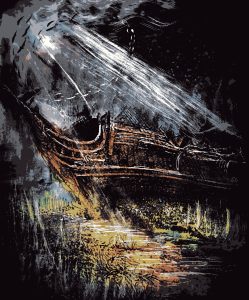An essay by Hugh Arden, as provided by Candida Spillard
Art by Luke Spooner
(A full report on this matter, drawn up by a team headed by Oceanographic Surveyor Hugh Arden, was to have been submitted to the Marine Accident Investigation Bureau.
When the request for the report was cancelled without explanation and Dr Arden transferred at short notice to a different project, he wrote up the salient points as an academic paper and submitted it to Journal of Maritime Archaeology. The paper was accepted for publication but, strangely, never published.
He has therefore passed a copy to his sister, Dr Candida Spillard, for safekeeping.)
~
Abstract
We present a possible cause of the demise of the Merchantman Lady Margaret, recently retrieved from the sea bed within the area of the Atlantic Ocean known as the Sargasso Sea.
The ship appears to have been catastrophically vandalised while still afloat, hundreds of miles from the nearest land, in what would have been a suicidal move by the crew at the time.
This paper describes the circumstances of the find and offers a tentative explanation for this bizarre state of affairs, based on a forensic examination of the ship’s structure and the artefacts found.
~
Background and Context
Recent advances in marine sensing and Remotely Operated Vehicle (ROV) technology have pushed back the frontiers of maritime archaeology to the point where it is now possible to locate, retrieve, and carry out thorough investigations of shipwrecks at practically any location, and in any depth of ocean.
The pioneering step in this area was the raising, in 1982, of Henry VIII’s flagship the Mary Rose which lay partially embedded in sand at a depth of 6 fathoms, two miles from shore under the estuary of the River Solent on the southern coast of England for over four centuries.

The first oddity noticed by divers on reconnaissance was the lack of an anchor chain in its windlass. There was no evidence of damage of the type that may have been done on losing the chain in rough seas.
To read the rest of this story, check out the Mad Scientist Journal: Summer 2017 collection.
Hugh Arden was Oceanographic Surveyor for the British Maritime and Coastal Agency until 2014. He is now an independent consultant.
Noting the coincidence of surname with the pilot of the Lady Margaret, along with family rumours of a West Indian connection, he calculated the possible course of a small boat adrift from the location of the wreck and concluded that it would have come ashore in the Bahamas.
A letter, published in the Nassau Guardian, elicited a flurry of responses from which it was eventually ascertained that one James Arden was in fact found, sunburned, starving and close to death, on Christmas Day 1772 on a windward beach by a lady walking her pet monkey. He eventually married the lady and they went on to raise a family of eight children and to found a school.
Candida Spillard is a lapsed physicist, having researched for over twenty years into the effect the weather has on radio wave reception.
She has a passion for all things environmental, self-sufficient, or just plain eccentric.
She has sometimes been used for the purposes of Mad Science, but has never knowingly come to harm.
The family do not, in fact, have any known links to the West Indies but there are rumours, on her mother’s side, of a Princess of the Raj marrying a British officer during those enlightened times before the Victorians put a stop to this sort of thing.
Luke Spooner, a.k.a. ‘Carrion House,’ currently lives and works in the South of England. Having recently graduated from the University of Portsmouth with a first class degree, he is now a full time illustrator for just about any project that piques his interest. Despite regular forays into children’s books and fairy tales, his true love lies in anything macabre, melancholy, or dark in nature and essence. He believes that the job of putting someone else’s words into a visual form, to accompany and support their text, is a massive responsibility, as well as being something he truly treasures. You can visit his web site at www.carrionhouse.com.
“The Curious Fate of the Merchantman Lady Margaret” is © 2017 Candida Spillard
Art accompanying story is © 2017 Luke Spooner
